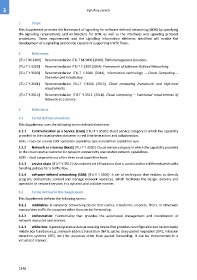Page 1358 - 5G Basics - Core Network Aspects
P. 1358
3 Signalling aspects
1 Scope
This Supplement provides the framework of signalling for software-defined networking (SDN) by specifying
the signalling requirements and architecture for SDN, as well as the interfaces and signalling protocol
procedures. These requirements and the signalling information elements identified will enable the
development of a signalling protocol(s) capable of supporting traffic flows.
2 References
[ITU-T M.3400] Recommendation ITU-T M.3400 (2000), TMN management functions.
[ITU-T Y.3300] Recommendation ITU-T Y.3300 (2014), Framework of Software-Defined Networking.
[ITU-T Y.3500] Recommendation ITU-T Y.3500 (2014), Information technology – Cloud Computing –
Overview and Vocabulary.
[ITU-T Y.3501] Recommendation ITU-T Y.3501 (2013), Cloud computing framework and high-level
requirements.
[ITU-T Y.3512] Recommendation ITU-T Y.3512 (2014), Cloud computing – Functional requirements of
Network as a Service.
3 Definitions
3.1 Terms defined elsewhere
This Supplement uses the following terms defined elsewhere:
3.1.1 Communication as a Service (CaaS) [ITU-T Y.3500]: Cloud service category in which the capability
provided to the cloud service customer is real time interaction and collaboration.
NOTE – CaaS can provide both application capabilities type and platform capabilities type.
3.1.2 Network as a Service (NaaS) [ITU-T Y.3500]: Cloud service category in which the capability provided
to the cloud service customer is transport connectivity and related network capabilities.
NOTE – NaaS can provide any of the three cloud capabilities types.
3.1.3 service chain [ITU-T Y.3512]: An ordered set of functions that is used to enforce differentiated traffic
handling policies for a traffic flow.
3.1.4 software-defined networking (SDN) [ITU-T Y.3300]: A set of techniques that enables to directly
program, orchestrate, control and manage network resources, which facilitates the design, delivery and
operation of network services in a dynamic and scalable manner.
3.2 Terms defined in this Supplement
This Supplement defines the following terms:
3.2.1 middlebox: A computer networking device that caches, transforms, inspects, filters, or otherwise
manipulates traffic for purposes other than packet forwarding.
3.2.2 orchestration: Functionality that provides the automated management and coordination of
network resources and services.
3.2.3 white-box: A general purpose data processing device that provides reconfigurable and customizable
middle box functions (e.g., network address translation (NAT), cache, deep packet inspection (DPI), intrusion
detection systems (IDS), etc.) for purposes other than packet forwarding. It can be implemented in a
virtualized manner.
1348

